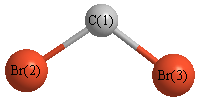Jump to
S2C1
Energy calculated at CID/3-21G
| | hartrees |
|---|
| Energy at 0K | -5157.788828 |
| Energy at 298.15K | -5157.793736 |
| HF Energy | -5157.625382 |
| Nuclear repulsion energy | 307.675556 |
The energy at 298.15K was derived from the energy at 0K
and an integrated heat capacity that used the calculated vibrational frequencies.
Geometric Data calculated at CID/3-21G
Point Group is C2v
Cartesians (Å)
| Atom |
x (Å) |
y (Å) |
z (Å) |
|---|
| C1 |
0.000 |
0.000 |
1.062 |
| Br2 |
0.000 |
1.645 |
-0.091 |
| Br3 |
0.000 |
-1.645 |
-0.091 |
Atom - Atom Distances (Å)
| |
C1 |
Br2 |
Br3 |
| C1 | | 2.0088 | 2.0088 |
Br2 | 2.0088 | | 3.2900 | Br3 | 2.0088 | 3.2900 | |
 More geometry information
More geometry information
Calculated Bond Angles
| atom1 |
atom2 |
atom3 |
angle |
|
atom1 |
atom2 |
atom3 |
angle |
| Br2 |
C1 |
Br3 |
109.954 |
|
Electronic energy levels
Charges, Dipole, Quadrupole and Polarizability
Jump to
S1C1
Energy calculated at CID/3-21G
| | hartrees |
|---|
| Energy at 0K | -5157.788285 |
| Energy at 298.15K | -5157.793213 |
| HF Energy | -5157.651301 |
| Nuclear repulsion energy | 301.108554 |
The energy at 298.15K was derived from the energy at 0K
and an integrated heat capacity that used the calculated vibrational frequencies.
Geometric Data calculated at CID/3-21G
Point Group is C2v
Cartesians (Å)
| Atom |
x (Å) |
y (Å) |
z (Å) |
|---|
| C1 |
0.000 |
0.000 |
0.749 |
| Br2 |
0.000 |
1.746 |
-0.064 |
| Br3 |
0.000 |
-1.746 |
-0.064 |
Atom - Atom Distances (Å)
| |
C1 |
Br2 |
Br3 |
| C1 | | 1.9256 | 1.9256 |
Br2 | 1.9256 | | 3.4910 | Br3 | 1.9256 | 3.4910 | |
 More geometry information
More geometry information
Electronic energy levels
Charges, Dipole, Quadrupole and Polarizability
